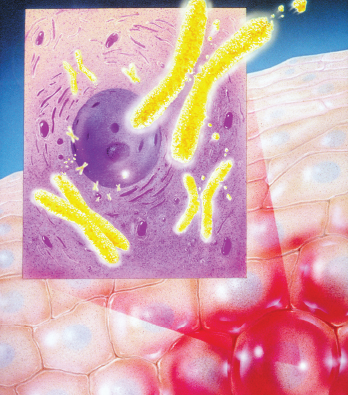
Jim Dowdalls / Science Source
Recent studies point to a relationship between scleroderma and autoantibodies (e.g., anti-RNA polymerase III or anti-RNPC3), and an increased cancer risk within a short interval of scleroderma onset. Mechanistic studies provide further evidence that cancer may trigger scleroderma in patients with these autoantibodies. However, many questions remain unanswered.
A study in the Annals of the Rheumatic Diseases by Ami A. Shah, MD, MHS, director of clinical and translational research at the Johns Hopkins Scleroderma Center (JHSC) in Baltimore, Antony Rosen, MD, director of the division of rheumatology and Vice Dean of Research at Johns Hopkins, and colleagues looked at autoantibody and disease phenotype subgroups to find indicators for those at high and low risk for cancer.1
Key Questions from Earlier Studies
“A few key questions emerged from prior studies,” says Dr. Shah. “How should we screen for underlying cancer in a patient with new-onset scleroderma and certain antibodies? If we detect an underlying cancer, does treating the cancer also effectively treat the scleroderma?”
Just under 2,400 patients from the JHSC observational cohort with their first visit between Jan. 1, 2000, and Dec. 31, 2015, were studied. They represented 37,686 person-
years. Of these, 205 (8.6%) developed cancer. Overall and site-specific cancer incidence was calculated in distinct autoantibody and disease phenotype subsets. They were then compared with the Surveillance, Epidemiology and End Results (SEER) registry.

Dr. Shah
“One limitation of the early research is that we were looking at cancer risk within a short interval of scleroderma onset for those positive for a particular antibody compared to scleroderma patients without that specificity,” says Dr. Shah. “However, scleroderma patients in these subgroups were not compared to individuals in the general population. Therefore, the magnitude of excess cancer risk and the tumor types at high risk were unknown.”
In this analysis the researchers examined cancer risk in distinct autoantibody and scleroderma phenotype subsets compared with the general population. This may provide insight into whether enhanced cancer screening should be further studied.
Four antibody categories were assessed. They included anti-centromere A/B, anti-topoisomere-1, anti-RNA polymerase III and those negative for anti-centromere, topoisomerase-1 and RNA polymerase III (CTP negative) antibodies. A person was deemed to be positive for a given autoantibody if they were ever positive based on clinically obtained assays. For all analyses, the timing of scleroderma onset was defined by the first appearance of scleroderma symptoms. Patient-reported cancer diagnosis and dates of diagnosis were obtained at first visit and confirmed through electronic medical records and pathology reports, if they were available.
“When we started publishing on the findings of higher cancer risk, people questioned whether we should perform aggressive cancer screening with CT of the chest, abdomen and pelvis or whole body PET/CT in these patients,” says Dr. Shah. “We weren’t sure this was the correct approach because there are risks, such as increased radiation exposure from imaging tests, higher costs and potential false positives resulting in more anxiety and unnecessary testing for the patient. In this study, we sought to define a rational starting point that could lay the foundation for study of cancer screening strategies in these patients.”
Within three years of scleroderma onset, cancer risk was increased in patients with RNA polymerase III autoantibodies (standardized incidence ratio [SIR] 2.84, 95% confidence interval [CI] 1.89–4.10) and those without centromere, topoisomerase-1 and RNA polymerase III antibodies (CTP negative; SIR 1.83, 95% CI 1.10–2.86).
“Among those who are anti-RNA polymerase III positive, cancer-specific risk may vary by scleroderma subtype,” she says. “Those with diffuse scleroderma had an increase in breast cancer risk, while those with limited disease may have high lung cancer risk. Our exploratory analyses also suggested that patients with RNA polymerase III antibodies may have an increase in the incidence of tongue and prostate cancers.”
One of the most interesting, and unexpected, findings: patients with anti-centromere antibodies (SIR 0.59, 95% CI 0.44–0.76) had a lower risk for cancer during follow-up than the SEER population. “Some intriguing data suggest that anti-DNA autoantibodies may have an anticancer effect, possibly explaining the decreased risk of breast and other cancers in patients with lupus,” says Dr. Shah. “It is interesting to hypothesize that anti-centromere immune responses might have anticancer properties as well, but further study is needed to assess this.”


